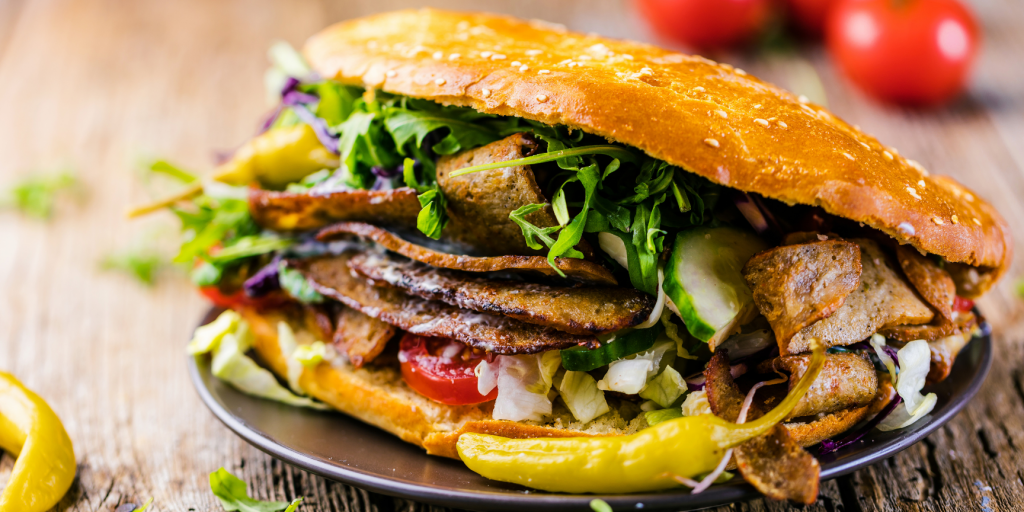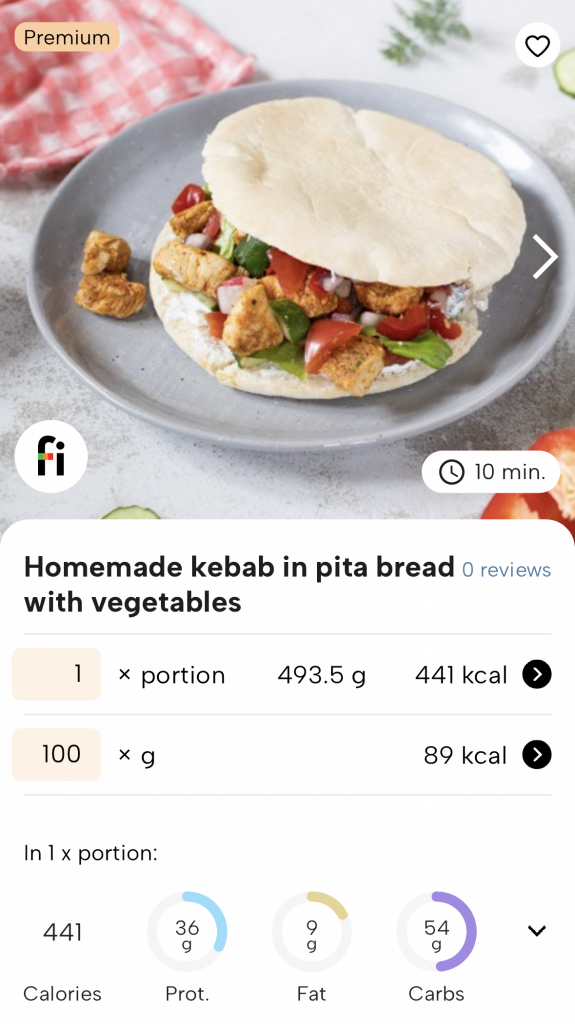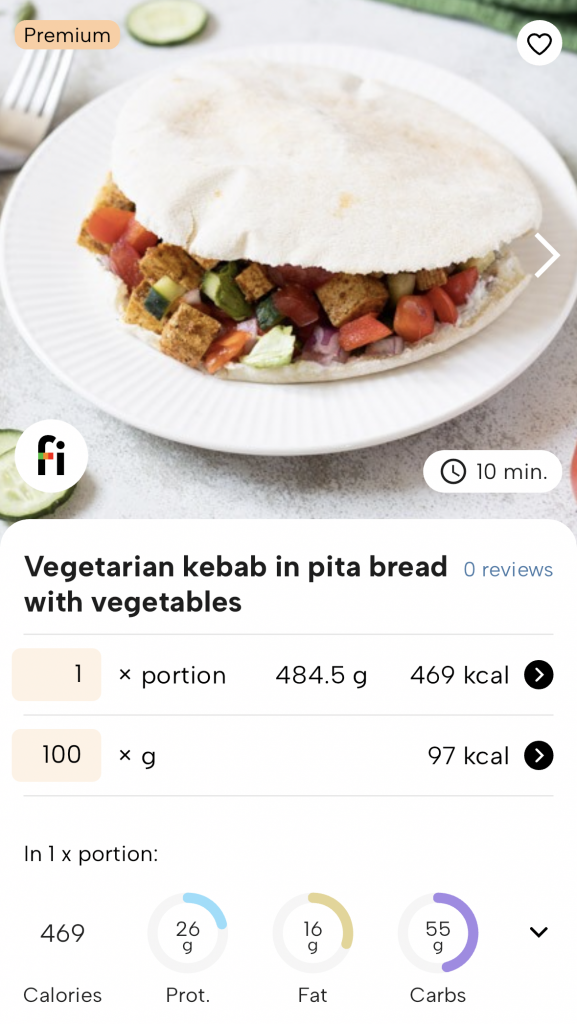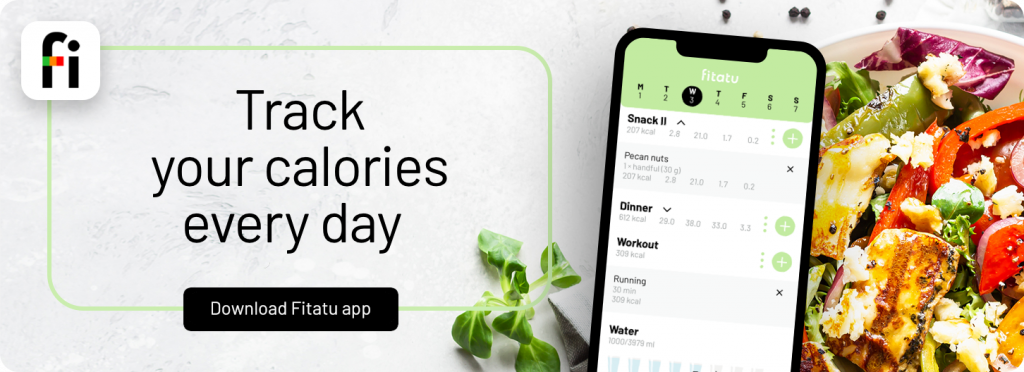How many calories are in kebab?

Kebabs are loved by both young and old. But can this popular street food be part of a healthy diet? How many calories does a kebab have? What determines its caloric content? Discover the Fitatu® recipe for kebabs and learn how to check the calorie count of your favourite kebab.
The kebab is a dish that dates back to ancient times, originating from the region of old Persia. It is considered a traditional dish of Turkish cuisine. Today, it enjoys immense popularity in many parts of the world, including Poland. The kebab is one of the top street food dishes, commonly enjoyed both during the day and after a night out.
What affects the caloric content of a kebab?
Kebabs can be prepared in many different ways, and the choice of ingredients will significantly impact their caloric content.
Meat or no meat
Traditionally, kebabs are made with lamb, which is a rich source of fat. In 100g of lamb shoulder, there are about 25g of fat, providing 287 calories. Kebabs can also be made with beef, where 100g of beef brisket contains 15.7g of fat and 219 calories. A healthier option would be chicken kebabs, as chicken is a lean meat and contains significantly less fat compared to other meats. Chicken thigh meat, for example, has 120 calories and 4.22g of fat per 100g.
Many people today choose not to eat meat, so vegetarian kebabs, which consist of just vegetables or are served with dairy, falafel, or plant-based meat substitutes, are also common. The caloric content can vary in these cases. Vegetable kebabs without any additional ingredients are typically low in calories. However, if cheese is added, the caloric content will depend on the type of cheese used. Halloumi, for instance, is a relatively fatty cheese and provides 321 calories per 100g. Due to its consistency, it is often used in these types of dishes. Therefore, a vegetarian kebab may not always be a lower-calorie option compared to a meat-based kebab.
Vegetables
In kebabs, you often find chopped, fresh vegetables like cabbage, tomatoes, cucumbers, and peppers, which are low in calories and only slightly affect the overall calorie content of the dish. However, in many popular kebab shops, you might encounter pre-made salads that often contain added sugar and/or oil, increasing the dish’s caloric content. Additionally, sometimes the vegetables served in kebabs are pre-fried in fat, which also raises their caloric value.
Type of bread
The type of bread used in a kebab also matters. Kebabs are typically served in buns or pitas, and sometimes they come wrapped in tortillas. A kebab in a pita is usually less calorific than one in a bun. When a kebab is served on a plate, it often comes with fries, which significantly increase the dish’s calorie count. Fries are usually deep-fried, which greatly contributes to the higher caloric content.
Sauces
The sauces used in a kebab can be the biggest calorie bomb. Many sauces added to kebabs are primarily made of mayonnaise, which is mostly fat. Just 30g of sauce can add up to 270 extra calories, and if multiple sauces are used, the calorie count can increase by several hundred more. Spicy sauces are typically lower in calories, as they usually contain less fat and are made from vegetables. Similarly, sauces based on natural yoghurt are also low in calories.
How many calories are in kebab?
As mentioned in the previous section, the caloric content of a kebab depends on several factors. Vegetarian kebabs, especially those with only vegetables, can provide fewer calories than traditional kebabs, ranging from 400 calories to around 900 calories if cheese is added. On the other hand, a meat kebab can have anywhere from 550 to over 1000 calories. For those looking to indulge, adding a triple serving of mayonnaise-based sauce can turn even a vegetarian kebab into a “calorie bomb” ?.
DIY kebab with Fitatu®
If you enjoy cooking, you should definitely try making your own kebab. You can calculate its caloric content using the Fitatu app. Save your recipes so you can use them again later. And if you’re looking for a delicious kebab recipe, we encourage you to try our chicken and vegetarian versions.
Homemade kebab in pita bread with vegetables

Vegetarian kebab in pita bread with vegetables

Fitatu® Support Group
Reaching your goal is easier with the support of others! Join our Fitatu Facebook group and achieve your goals together with other Fitatu® app users. With the group members, you can share your results every day and motivate each other to keep going.

Fitatu® App
Not yet familiar with Fitatu®? Download the app from the Play Store or Apple Store and start taking charge of your health with us! Do you want to have access to all the features? Go for Fitatu® Premium! For blog readers, we have a special discount code: KEBAB-6X. Go to https://www.fitatu.com/app/order-and-payment and claim a 20% discount on Fitatu® Premium annual plans. The code combines with other promotions.





